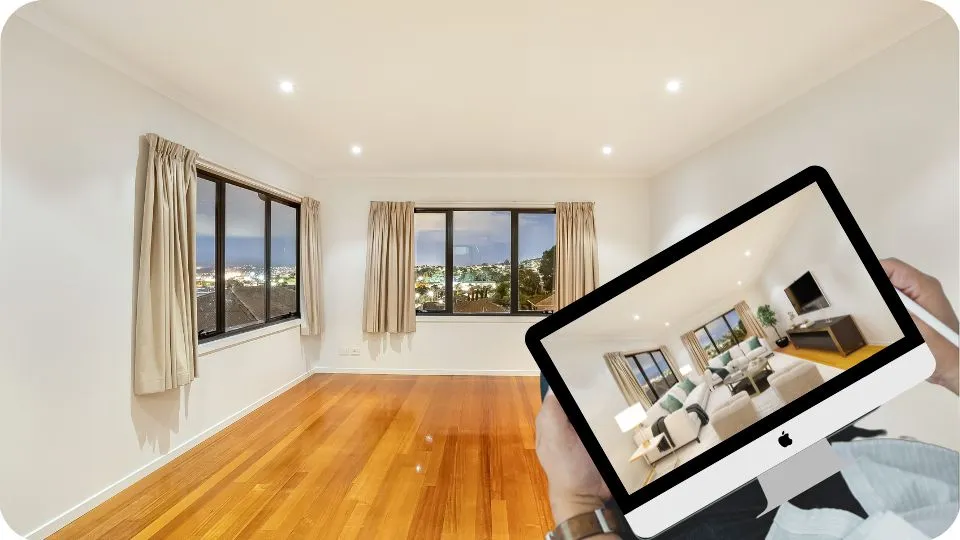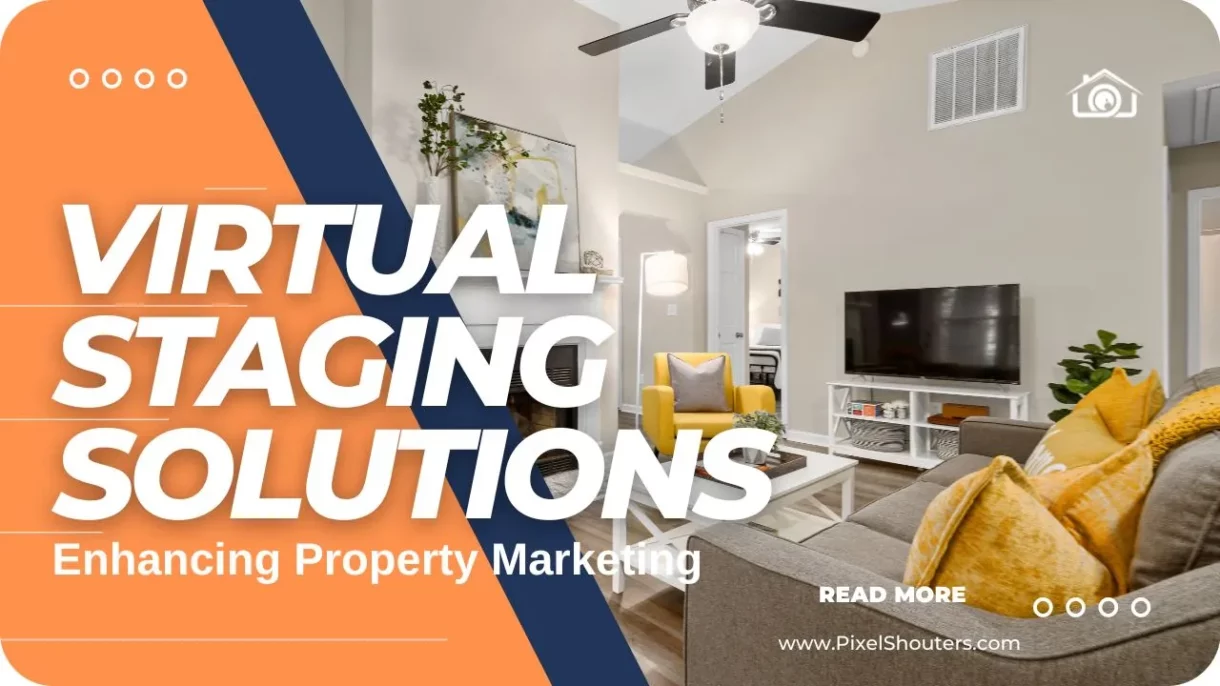Virtual Staging Solutions for Real Estate: Enhancing Property Marketing
Are you looking for a way to make your property stand out in a competitive real estate market? Virtual staging may be the solution you need. This innovative technique uses computer-generated images to create a realistic representation of a home’s interior, enhancing its appeal and attracting potential buyers. Not only is it cost-effective and time-efficient, but it also allows for customization and flexibility in staging, making it a popular choice for real estate marketing.
In this blog, we’ll delve into the virtual staging solutions benefits, how it works, and why it’s becoming an increasingly popular solutions for property marketing. Whether you’re a real estate agent or a homeowner looking to sell your property, read on to learn more about how virtual staging can optimize your property marketing strategy.
Quick Jump List
What is Virtual Staging?
Virtual staging is the process of creating realistic digital images of a property, with furniture, decor, and other elements added to enhance its visual appeal. It is a cost-effective and convenient alternative to traditional staging, where physical furniture and decor are used to decorate a property. Virtual staging solutions are offered by a range of providers, with different types of virtual staging available depending on the provider and the needs of the property.
Benefits of Virtual Staging for Real Estate
Virtual staging offers a range of benefits for real estate agents, sellers, and potential buyers, including:
- Cost-effectiveness: Virtual staging is significantly less expensive than traditional staging, where furniture rental and transportation costs can add up quickly.
- Flexibility and Convenience: Virtual staging can be done remotely, without the need for physical access to the property. This allows real estate agents and sellers to save time and effort compared to traditional staging.
- Customizability: Virtual staging offers the ability to customize the decor and furniture to suit the target audience. This is particularly useful in cases where a property may have a specific style or design that may not appeal to everyone.
- Showcase Different Styles and Furniture Options: With virtual staging, it is possible to showcase different styles and furniture options for the same property, allowing potential buyers to envision the potential of the space in different ways.

- Helping Potential Buyers Envision the Potential of a Space: Virtual staging can help potential buyers visualize how a space can be used and what it might look like with furniture and decor. This can be particularly useful in cases where the property is vacant or has outdated furniture that may be difficult to envision in a more modern style.
How Virtual Staging Works
Virtual staging involves a series of steps to create realistic digital images of a property. These steps may vary depending on the provider, but typically involve the following:
- Room Measurements: The provider will typically ask for accurate measurements of each room in the property to ensure that the virtual staging is proportional and accurate.
- High-Quality Photos: The provider will require high-quality photos of each room in the property, which may be taken by the real estate agent or photographer.
- Selection of Furniture and Decor: The provider will typically offer a range of furniture and decor options for the real estate agent or seller to choose from. The furniture and decor are selected based on the target audience and the style of the property.
- 3D Modeling and Rendering: Using 3D modeling software, the provider will create a digital version of each room in the property. The furniture and decor selected in step 3 will be added to the digital version of the room to create a realistic representation of what the room might look like with physical furniture and decor.
- Collaborative Process: The virtual staging provider will work closely with the real estate agent or seller to ensure that the virtual staging is accurate and meets their expectations. The process may involve multiple revisions and adjustments to the virtual staging before the final images are created.
Potential Drawbacks of Virtual Staging
While virtual staging has many benefits, it is important to consider potential drawbacks as well. These include:
- Limitations in accurately representing the texture and feel of physical furniture and decor: While virtual staging can create realistic images, it may not fully capture the texture and feel of physical furniture and decor.
- Potential for misrepresenting the actual size of rooms or furniture: Virtual staging may not always accurately represent the size and proportion of rooms or furniture, which can lead to unrealistic expectations for potential buyers.
- Risk of over-staging and making the property appear unrealistic: It is important to strike a balance between enhancing the visual appeal of a property and maintaining a realistic representation of the property.
- Importance of disclosing that the images are virtually staged to avoid misleading potential buyers: It is important to be transparent about the fact that the images are virtually staged to avoid misrepresenting the property to potential buyers.

Use Cases for Virtual Staging
Virtual staging can be used in a variety of scenarios, including:
- Vacant or Unfurnished Properties: Virtual staging can be used to enhance the visual appeal of vacant or unfurnished properties, helping potential buyers visualize the potential of the space.
- Properties with Outdated or Unappealing Furniture: Virtual staging can replace outdated or unappealing furniture with more modern and appealing options.
- Properties with Unique Layouts that Require Visual Clarification: Virtual staging can be used to clarify the layout of properties with unique or unusual layouts that may be difficult to envision without furniture and decor
Choosing a Virtual Staging Provider
When choosing a virtual staging provider, it is essential to consider factors such as:
- Quality of Virtual Staging: The quality of the virtual staging images should be high, with realistic furniture and decor that accurately represents the property.
- Customizability: The virtual staging provider should be able to customize the furniture and decor to suit the style and target audience of the property.
- Turnaround Time: The virtual staging provider should be able to deliver the virtual staging images in a timely manner to ensure that the property can be marketed quickly.
- Cost: The cost of virtual staging should be reasonable and cost-effective compared to traditional staging.
- Customer Service: The virtual staging provider should offer excellent customer service, with responsive communication and a willingness to address any issues or concerns.

If you’re looking for a virtual staging provider, you may come across PixelShouters, a virtual staging company that offers a range of virtual staging solutions for real estate professionals and sellers. PixelShouters is a virtual staging provider that offers high-quality, customizable virtual staging solutions for real estate professionals and sellers. They use advanced 3D rendering technology to create realistic images of properties and offer a range of virtual staging solutions including virtual staging, virtual renovation, and virtual decluttering.
When choosing a virtual staging provider, factors to consider include quality, customizability, turnaround time, cost, and customer service. PixelShouters offers competitive pricing, responsive customer service, and fast turnaround times for their virtual staging solutions.
Conclusion
Virtual staging is a powerful tool for enhancing the visual appeal of properties in the competitive world of real estate. It offers a cost-effective, convenient, and customizable alternative to traditional staging, with the ability to showcase different styles and furniture options for the same property. While virtual staging has its limitations, it can be an effective way to help potential buyers envision the potential of a space and improve the marketing of real estate properties. When choosing a virtual staging provider, it is essential to consider factors such as quality, customizability, turnaround time, cost, and customer service.
